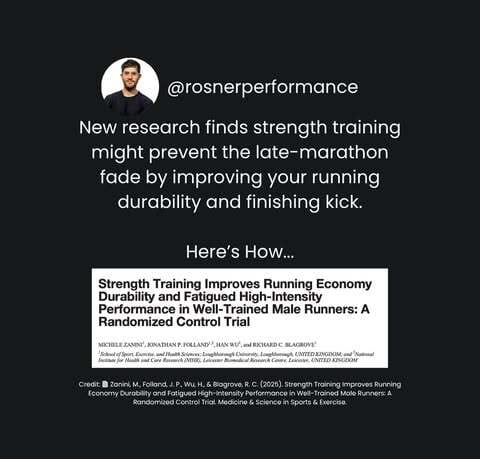Stop Wasting Time on Recovery Tools That Don’t Work—Here’s What Actually Does
Estimated read time: 3.6 minutes (about as long as your neighbor’s ice bath rant). 😉
Hey Performance Nerds! Jonah here. 🤓
Here’s a $500 question: Which recovery tool actually makes you faster?
A) The $400 massage gun Instagram won’t shut up about
B) Those “graduated pressure” compression tights
C) That trendy cold plunge tub all over TikTok
D) None of the above
If you guessed D, congrats. You’re already smarter than half the fitness industry.
🧪 Let’s Science:
Why foam rolling isn’t the performance tool you think it is (and what to do instead)
The cold plunge mistake no biohacker talks about
The only recovery method backed by hard science
Why massage guns might be a $200 placebo
How to build a recovery plan that actually drives adaptation
🧬 Performance Sponsor:
🚀 Train Harder. Recover Smarter. Save 15%.
SiS—the same science-backed fuel trusted by Olympic marathoners—is now sponsoring Marathon Science.
From hydration mixes to recovery tools, every product is backed by real performance data and built for serious athletes like you.


🧊 Cold Plunges: Friend or Gains-Killer?
Cold plunges are everywhere—and yes, they might reduce soreness and inflammation.
But if you’re chasing muscle growth or long-term adaptation?
Timing is everything.
⚠️ The Inflammation Paradox
Inflammation isn’t just a side effect of training. It’s the signal your body uses to repair and grow.
🧪 A 2025 study found that cold water immersion immediately after lifting restricted microvascular blood flow, reduced amino acid delivery, and suppressed muscle protein synthesis.
Translation: Ice baths right after lifting may short-circuit your gains.
✅ How to Use Cold Plunges (Strategically)
Best for:
Multi-event weekends
Deloads or off days—if you like how they make you feel, go for it
(Just avoid them close to workouts if you care about gains)
Avoid after:
Heavy lifting sessions
Hypertrophy-focused blocks
Bottom line: Cold plunges can work mostly because they subjectively make you feel better in the short term.
But if you’re in a muscle-building phase? Skip the ice tub and let your body recover naturally.
🧷 Foam Rolling: Feels Good, Doesn’t Boost Gains
Foam rolling is the golden retriever of recovery tools: friendly, familiar, and always hanging around. 🐾
It might ease soreness, but don’t expect it to boost performance.
✅ What It Might Do
Increase temporary range of motion
Reduce muscle soreness (DOMS)
Improve perceived recovery
🧪 One meta-analysis called performance effects "minor and partly negligible."
🧠 Smart Use (If You Like It)
Use before workouts for light mobility or warm-up
Don’t rely on it for strength, speed, or hypertrophy
Risk: low. Feel-good factor: high.
Bottom line: If foam rolling helps you feel better, go for it. If not? Skip it. You’re not missing much.
💥 Massage Guns: More Marketing Than Muscle
Are massage guns actually effective, or is science about to save you $200 (and fund a year’s worth of ice cream instead)?
🧬 What the Research Says
Some small studies show improved short-term flexibility
No strong evidence they enhance strength, performance, or speed recovery
In most cases, they’re no better than rest—or doing nothing at all.
⚠️ What to Know
Traditional massage: Proven to help reduce perceived soreness and aid relaxation
Massage guns: Still waiting for robust evidence
Red flag: Intensity doesn't equal effectiveness, more pressure may increase injury risk
Bottom line: If you love using a massage gun and it helps you chill out, fine.
But don't expect it to enhance your recovery in any meaningful way. If you're skipping it, you're not missing much.
🧶 Compression Gear: Helpful, But Don’t Expect Miracles
Compression garments get more hype than my dog Augie when he sees a squirrel. While the science isn’t overwhelming, there’s some merit.
They may help reduce soreness and slightly improve strength recovery.
But let’s be clear:
They don’t improve running performance.
The benefits are modest.
And considering the price tag? They're far from essential.
🧰 Practical Use
Best for: Helping you feel a bit less sore after races or big training blocks
Not for: Improving performance metrics like speed or endurance
Cost vs. return: Small gains, high cost
Bottom line: Compression gear might help you feel better. But if you're tight on budget? You're not missing out on major gains by skipping it.
🧠 Perception vs. Physiology: The Real Recovery Divide
Feeling recovered ≠ being recovered.
Most tools reduce perceived soreness, but not actual physiological fatigue or tissue damage.
That’s fine and can support recovery. Just make sure you’re not skipping sleep or underfueling to make time for a gadget.
🟡 Recovery That Actually Works
Forget the gimmicks—these are the pillars that actually move the needle. Let’s break them down:
🥩 Nutrition: The Metabolic Foundation
Low energy = slow recovery and weak adaptation. Here’s what tanks when you underfuel:
Hormones crash (thyroid, IGF-1) → sluggish repair, slower metabolism
Muscle building stalls → breakdown > rebuild
Performance drops → endurance, speed, and power all take a hit
The fix:
Protein: 1.6–2.0g/kg bodyweight/day
Carbs: Scale to training load (more volume = more carbs)
Calories: Stay at or above maintenance, especially during big weeks
Food isn’t just fuel—it’s your body’s recovery signal.
✔️ Don’t dip below maintenance
✔️ Prioritize protein + carbs around training
✔️ Consistent underfueling = consistent under-recovery
✔️ Want faster recovery and fewer injuries? Eat enough.
😴 Sleep: Your Secret Weapon
Target: 8–10 hours per night. No hacks. No substitutes.
Sleep powers:
Hormonal repair
Neural recovery
Motor learning
🧪 A 2025 meta-analysis (45 studies) found sleep loss significantly reduces:
Endurance (–0.66), power (–0.63), max strength (–0.35)
Speed, skill, and overall recovery
Plus: Increased perceived effort
👉 Consistent sleep beats cold plunges every day of the week.
📊 Smart Load Management: Don’t Spike, Don’t Snap
The fastest way to ruin recovery? A sudden jump in training load.
Going from 10 to 50-mile weeks isn’t just bold, it’s reckless.
Research shows rapid spikes in volume or intensity are top predictors of injury. Your body can adapt, but only if the stress is gradual.
⚠️ What Happens When You Overdo It:
Too much, too fast = breakdown, not adaptation
Recovery systems get overwhelmed → fatigue you can’t bounce back from
Even elites break down when stress outpaces capacity
Progressive overload = planned, steady increases. Not “I felt good so I doubled my long run.”

Practical Summary: Recovery Hierarchy


💬 One last thing before you go.
After the NFL, I wasn’t sure if obsessing over performance science still mattered—until I started helping this community.
Your training goals? They brought that fire back.
So if you're feeling stuck, second-guessing something, or just want to share how training's going—hit reply. I read every message, and I’m here to help however I can.

🚨 Strength Training Prevents Late Marathon Bonking
Did you miss my post about how strength training might prevent late marathon bonking? You can find it below!
I won’t lie. These posts take me a while to make. If you find it helpful, share it on your story or with a friend. It helps me a ton!

Are You a True Running Nerd? Prove it.. 🧐
Welcome to the prove you’re a nerd section. Each week, I ask a question about a common running science myth.
Answer correctly, and you’ll be entered into a weekly raffle to win a package of Jonah’s favorite supplements.
Your muscles get a lot of attention, but your liver might be the unsung hero of your long run. What’s one of the liver’s most important jobs during endurance efforts? 🧠

Last Week’s Results: Your Calf Is the Real MVP 🦵🔥
Most of you were on the money, but it’s time to give some overdue love to one muscle that quietly powers your stride mile after mile.
The correct answer?
C. Soleus (deep calf muscle) ✅
Not the glutes. Not the quads. It’s the soleus—the deep, endurance-specialist calf muscle—that does the most mechanical work in distance running, even up to elite-level paces like 3:50 per mile.
This muscle is slow-twitch dominant, fatigue-resistant, and works overtime to absorb force and return energy with every step.
Here’s how the votes shook out:
⬜️ A. Gluteus maximus 🍑 – 77 votes
⬜️ B. Rectus femoris (quad) – 31 votes
🟩 C. Soleus (deep calf muscle) – 126 votes ✅
⬜️ D. Biceps femoris (hamstring) – 26 votes
Total votes: 260
Bottom line?
Don’t overlook calf strength—especially the soleus, which doesn’t get as much love as the showy gastrocs.

Don’t forget: You + Science = AWESOMENESS 😎
Yours in science,
Jonah
P.S. - We have a crew of 17,230+ nerds here who are running FAST using science.
Did you need running science advice or tips? 🏃♀️💨🧪
Reply with your question, Augie and I (pictured below) will get back to you with science-backed tips!


Enjoy the newsletter? Please forward to a pal. It only takes 18 seconds. Making this one took 11.23 hours.
Please email me directly if you’re interested in references for this week!


